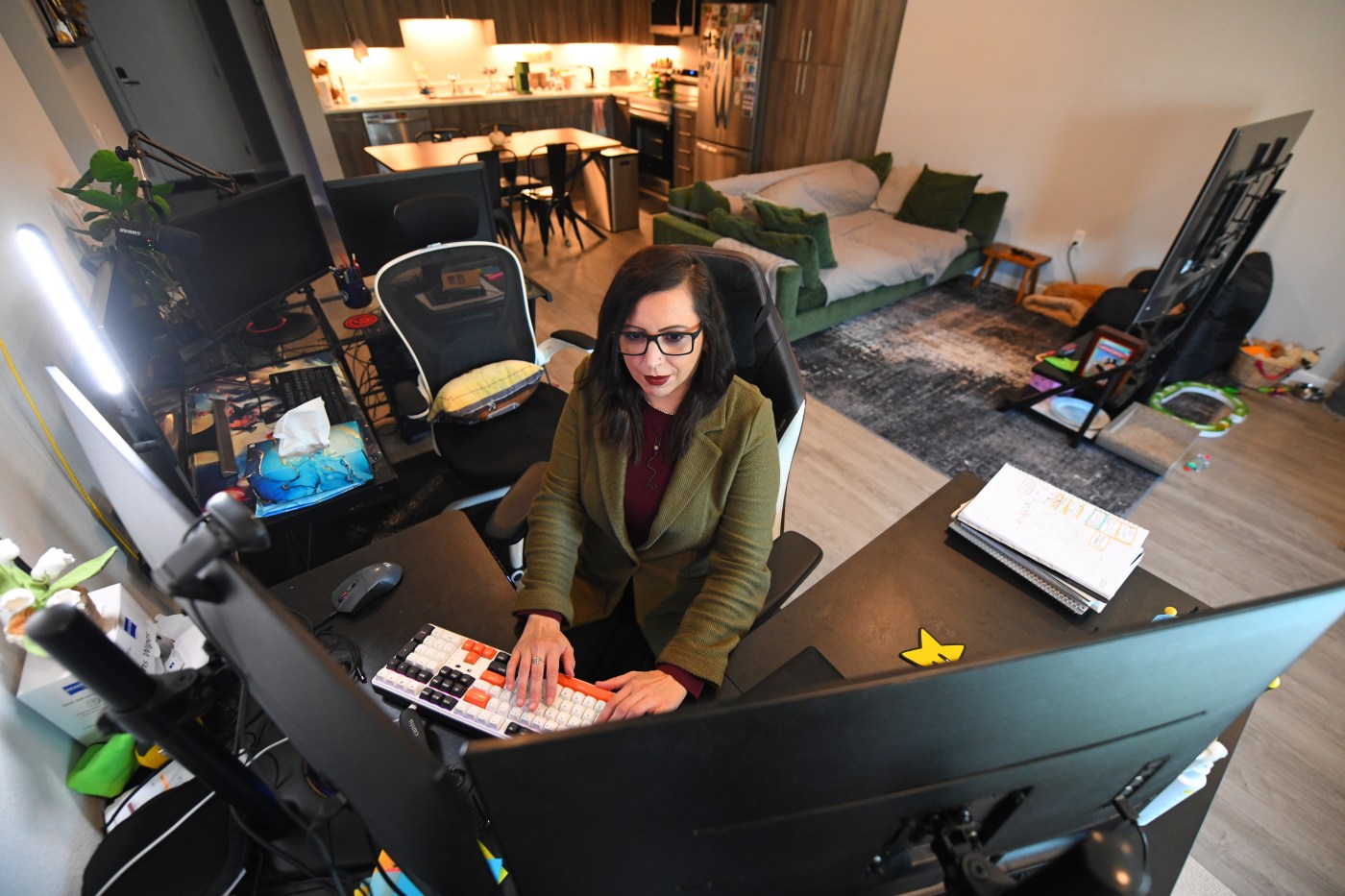The era of baking bread on a weekday morning or wearing pajama bottoms below an ironed shirt for video office meetings appears to be on the wane in the Bay Area.
Lockdowns during the early stages of the COVID pandemic wrought seismic, lasting changes to the way people work, with full-time at-home employment leading to widely adopted hybrid mixes of remote and in-office work that remain popular among many workers and employers.
But a new poll suggests remote work is fading, and even hybrid models are losing ground. This year, nearly two-thirds of employed respondents say they worked fully in-person, compared to fewer than half last year, according to the poll by Bay Area News Group and Joint Venture Silicon Valley, a regional think tank.
“It’s a surprising result,” said Russell Hancock, Joint Venture’s president and CEO. “We have seen many employers say, ‘The game’s up, we need you back in the office.’ I’m hearing that most of all in the intensive areas of our economy like AI and the startup environment. This has become a hard valley … as opposed to the soft valley when everyone was enjoying their perks, having their work-life balance.”
2025 BAY AREA POLL: After pandemic gloom, are Bay Area residents feeling more optimistic about the region?
The poll results are based on 1,743 interviews conducted Aug. 12 to Aug. 19 with adults in Santa Clara, Alameda, Contra Costa, San Mateo and San Francisco counties from August 12-19, 2025, with a margin of error of approximately 2.6%.
Google, Meta and Apple, which maintain hybrid work environments, did not respond to questions about their future in-person plans. In September, Amazon CEO Andy Jassy cited the pursuit of innovation, collaboration and connection in ending the company’s three-days-in the-office hybrid model and ordering employees — including those at the company’s Bay Area offices — back in five days a week.
Related Articles
Forget stock options. Some Bay Area employers are handing out down payments
Bay Area, California post small job gains for August as hiring stalls
Walmart will shut East Bay store and eliminate scores of jobs
California’s Great America chops jobs as uncertainty looms
1.2 million immigrants are gone from the US labor force under Trump, preliminary data shows
Remote and hybrid work schedules have played a villain’s role in the struggles of Bay Area downtowns, also hollowed out by society’s shift from in-person to online shopping.
“Without these workers coming downtown, the service sectors and the retail sectors are really going to struggle,” said Abby Raisz, vice-president of research at the Bay Area Council, which represents Bay Area businesses.
Pedestrians walk near Salesforce Tower in San Francisco, Calif., on July 2, 2025. Badge-in data from building-security giant Kastle indicates office occupancy has sluggishly bounced back from what it was before COVID, with San Francisco at about 42% occupancy. (Dai Sugano/Bay Area News Group)
At Berliner Cohen law offices in downtown San Jose, the approximately 125 attorneys and staff were called back to the office full time in mid-2021.
RELATED: Retirement in the Bay Area: Poll finds many seniors face bare-bones budgets, mounting debts
“It was to rebuild our sense of community and culture,” said firm partner Christine Long, who wasn’t among those polled.
Still, while polls and other measurements produce varied results, office-based work clearly remains below pre-pandemic levels. Bay Area office vacancy rates are among the highest in the U.S., at 24%, compared to 19% nationwide, according to researcher CommercialCafe. Demand for office space will probably not return to pre-pandemic levels, said Santa Clara County Assessor Greg Monteverde, since working from home “seems to be at some level something that is going to be fairly permanent.”
A drone view of an office building in downtown Oakland, Calif., on Monday, May 5, 2025. Office-based work clearly remains below pre-pandemic levels. Bay Area office vacancy rates are among the highest in the U.S., at 24%, compared to 19% nationwide, according to researcher CommercialCafe. (Jane Tyska/Bay Area News Group)
Badge-in data from building-security giant Kastle indicates South Bay office occupancy has sluggishly bounced back to barely over half what it was before COVID, while the San Francisco region falls even shorter at around 42%. A survey by Stanford University, the Hoover Institution, and Instituto Tecnológico Autónomo de México found days worked fully at home in the Bay Area dropped only 2% this year, to 30%.
2025 BAY AREA POLL: High cost of living forces residents to delay medical procedures, having kids
Rod Timoteo, owner of Mystérieux Hair Salon, works on his client Jerome Delara’s haircut at San Pedro Square in San Jose, Calif., on Thursday, Sept. 25, 2025. “It’s been really tough,” said Timoteo, who opened the hair salon in downtown San Jose in 2022. “From 9 a.m. to 4 p.m., it’s almost a ghost town.” (Ray Chavez/Bay Area News Group)
“It’s been really tough,” said Rod Timoteo, who opened Mystéreiux hair salon in downtown San Jose in 2022 and wasn’t among the Bay Area poll respondents. “From 9 a.m. to 4 p.m., it’s almost a ghost town.”
“However, “some businesses want their employees to come into the office more,” Timoteo said, and with new enterprises opening nearby, “we’re now starting to get more traffic.”
Meanwhile, the number of visitors coming to downtown San Jose for all purposes rose 7% this year to 3.3 million, compared to 3.7 million during March of 2019 before the pandemic, according to cell phone data analyzed by market-intelligence company Placer.ai. Downtown Oakland saw just a 2% increase this year, to 3.6 million visitors, while downtown San Francisco received a 5% bump.
The San Jose region’s faster bounce-back may be attributable in part to an easier commute to work than in San Francisco and the East Bay, and tech campuses with free parking, making in-office work more appealing, the Bay Area Council’s Saisz said.
Work colleagues Maria Palomares, center, and Jeanette Martinez, right, walk to lunch in downtown on Thursday, Oct. 2, 2025, in San Jose, Calif. The number of visitors coming to downtown San Jose for all purposes rose 7% this year to 3.3 million, compared to 3.7 million during March of 2019 before the pandemic. (Aric Crabb/Bay Area News Group)
In downtown San Jose, one of Berliner Cohen’s lawyers, Maria Palomares, 33, who wasn’t among those polled, has resumed her pre-pandemic habit of buying lunch nearby most every day.
“We used to go to San Pedro Square all the time,” she said.
Employers remain divided on which employment models work best. Offering options to work from home can help recruitment and worker retention, and employee-monitoring technologies can promote productivity, said Anis Uzzaman, CEO of San Jose venture capital firm Pegasus Tech Ventures.
Pegasus Tech Ventures CEO Anis Uzzaman works in his office on Tuesday, Aug. 22, 2023, in San Jose, Calif. Offering options to work from home can help recruitment and worker retention, and employee-monitoring technologies can promote productivity, said Uzzaman. (Dai Sugano/Bay Area News Group)
At other companies, leaders and managers said communication among workers, teams and managers improves when all are together on site, Uzzaman said. With layoffs prevalent in tech, employers have more leverage to mandate in-office work, Uzzaman said.
Since the start of the pandemic, Juanita Alvarez — a paralegal, business student and budding entrepreneur — has worked from home in San Jose for Amazon in Sunnyvale, then commuted to Cupertino three days a week on a hybrid schedule for Apple, then worked a fully remote job for a San Francisco cybersecurity firm after moving to Oakland.
“Let’s say that I’ve got a few job opportunities, and two of them are remote, and one’s hybrid — then I just take the remote role,” said Alvarez, 45, a poll respondent.
Juanita Alvarez, of Oakland, works remotely at her home on Thursday, Sept. 25, 2025. Alvarez started working from home back in 2019. Alvarez has hedged her bets: She located herself in West Oakland to cut rental costs, and also to get close to BART. (Jose Carlos Fajardo/Bay Area News Group)
Still, Alvarez has hedged her bets: She located herself in West Oakland to cut rental costs, and also to get close to BART.
“If I find myself in a position where I have to go back to the office for five days a week, I would rather be in a place where it’s not going to be too hard on me,” Alvarez said.
Downtowns haven’t been the only casualty of remote and hybrid work: transit ridership plunged, especially on BART and Caltrain. But over the past year, Bay Area transit use has generally trended upward, while burgeoning, post-pandemic highway congestion has stabilized, said Sebastian Petty, a senior adviser for transportation policy at public policy research nonprofit SPUR.
Related Articles
Forget stock options. Some Bay Area employers are handing out down payments
Bay Area, California post small job gains for August as hiring stalls
Walmart will shut East Bay store and eliminate scores of jobs
California’s Great America chops jobs as uncertainty looms
1.2 million immigrants are gone from the US labor force under Trump, preliminary data shows
With traffic back, transit has become more appealing, especially for those with time-consuming commutes and costly parking fees, Petty said.
Petty noted that local transit services are facing funding troubles that could mean service cuts and worse traffic.
More congestion would provide an even greater deterrent for customer-support engineer Hamilton Wu of Pleasanton to commute. His employer in San Jose officially wants him in the office two to three times a week, but he manages to keep it to once every couple weeks, said Wu, a poll respondent.
“I don’t mind being there,” said Wu, 27. “I just mind having to commute.”





